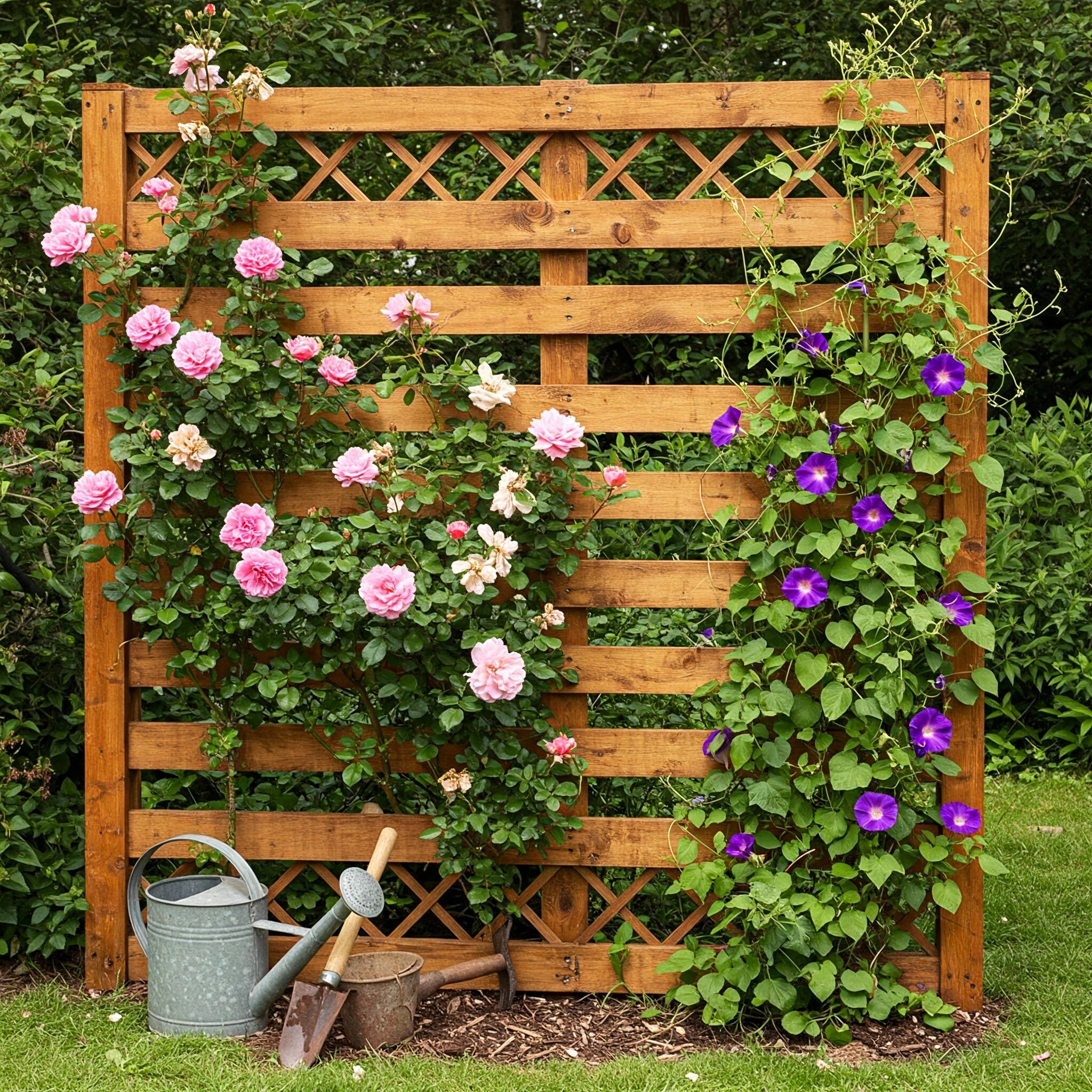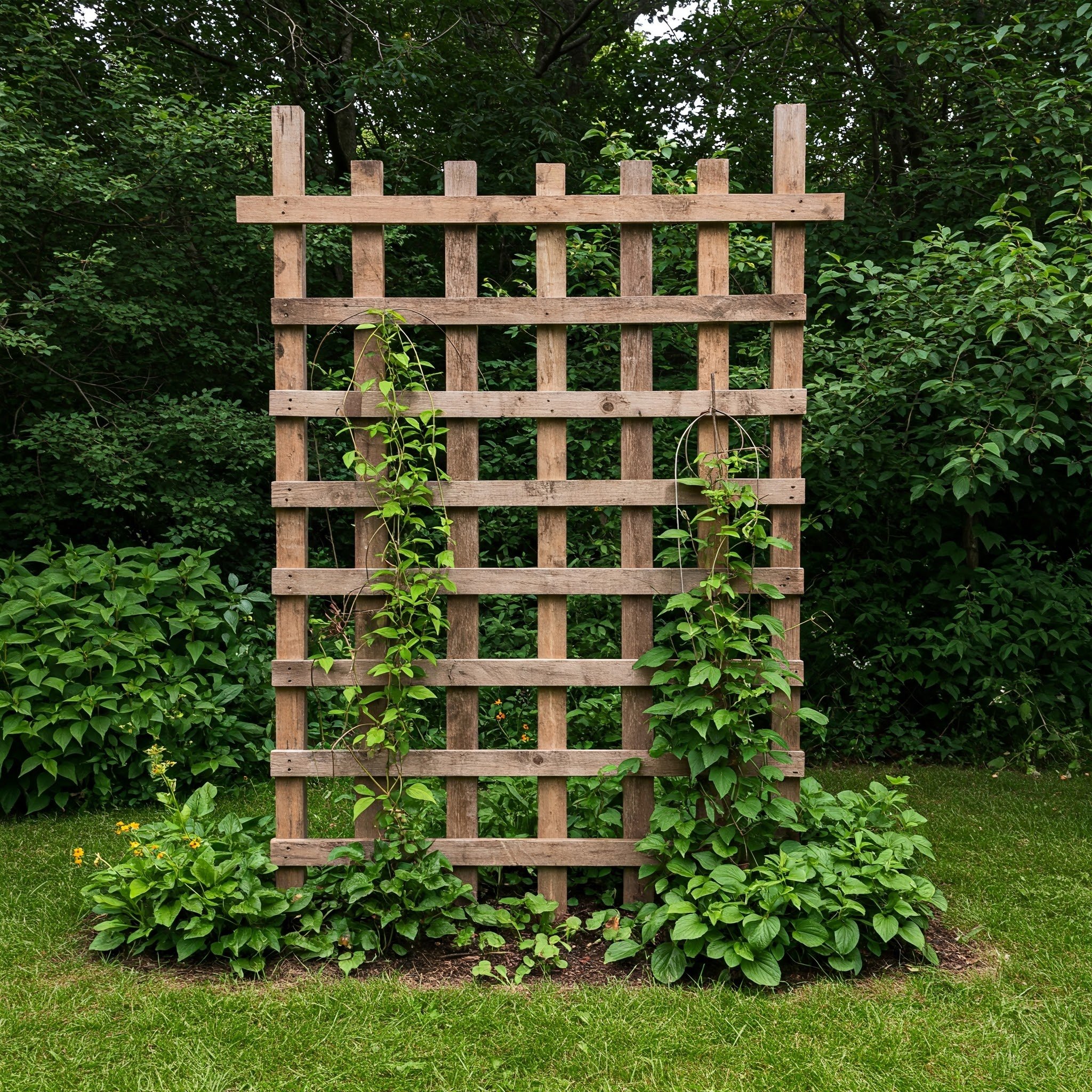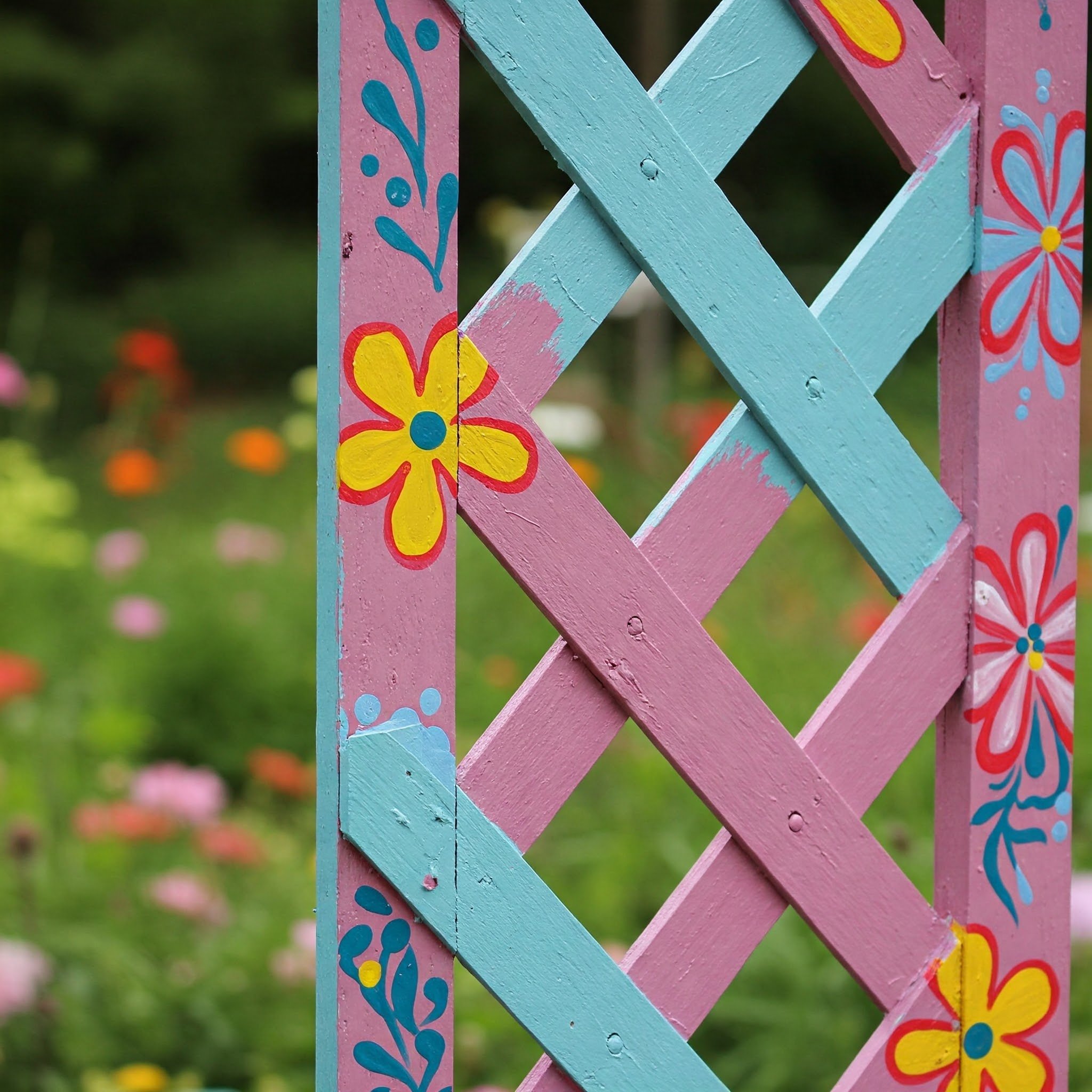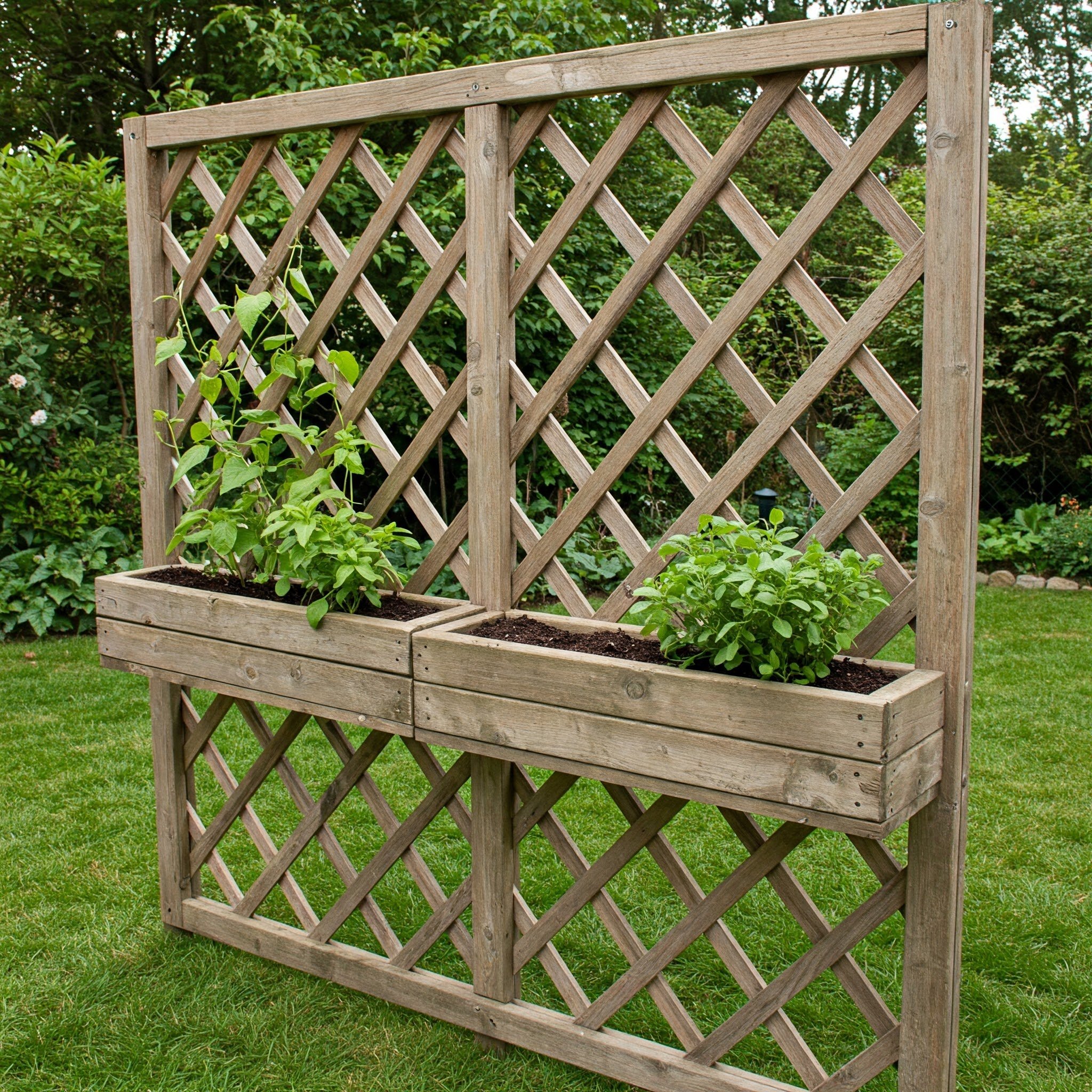15 DIY Garden Trellis Ideas for Lush Vines
Discover 15 creative DIY garden trellis ideas that bring lush vines and vibrant life to your outdoor space. Transform your garden with innovative, eco-friendly designs that inspire and support your green dreams.
Imagine stepping into your garden and seeing vibrant vines winding gracefully over custom-built trellises that you crafted with your own hands. DIY garden trellis projects not only add a burst of personality and style to your outdoor oasis, but they also support sustainable gardening practices and offer a fun way to express your creativity. Whether you’re a seasoned gardener or a beginner eager to try something new, these 15 innovative trellis ideas will spark your imagination. Let’s explore how you can blend practicality with art, turning your garden into a living canvas where nature and design coalesce in perfect harmony.
1. DIY Garden Trellis Ideas: An Overview – Why Choose a DIY Approach?
Building your own garden trellis opens up a world of creative possibilities and personal satisfaction. When you craft a trellis with your own hands, you infuse your outdoor space with a unique charm that no store-bought design can match. DIY projects invite you to explore various materials, experiment with textures, and customize every inch to fit your garden’s vibe. Not only does this approach allow you to tailor the design for your specific vines and plants, but it also teaches you new skills and deepens your connection with nature. Imagine the thrill of watching your lush vines climb over a structure you built from scratch—a true labor of love that marries practicality with personal flair, making every gardening moment more meaningful.
2. Rustic Wooden Trellis Charm – Embracing Natural Textures
Rustic wooden trellises bring a timeless, earthy appeal to your garden that harmonizes effortlessly with nature. Using reclaimed or locally sourced wood, you can construct a trellis that exudes warmth and authenticity. The natural grains and weathered textures of the wood tell a story of nature’s enduring beauty, while simple joinery techniques offer a satisfying challenge to DIY enthusiasts. As your vines wrap themselves around the wooden framework, they create a dynamic interplay between man-made structure and natural growth. This approach not only enhances the rustic charm of your garden but also encourages sustainable practices by repurposing materials. With each nail and board, you build a canvas for your plants to flourish, making your outdoor sanctuary a living tribute to nature’s artistry and your creative spirit.
3. Industrial Metal Trellis Design – Strength Meets Style
Industrial metal trellises offer a striking contrast to the softness of climbing vines by introducing a sleek, robust aesthetic into your garden. These designs leverage metal’s durability and modern edge to create structures that are both functional and visually appealing. When you work with metal, you can experiment with clean lines, geometric patterns, and even industrial finishes that add an urban vibe to your outdoor space. The interplay between hard metal and delicate vines creates a unique dialogue of strength and grace. Plus, metal trellises are ideal for supporting heavy, sprawling vines while requiring minimal maintenance. This design approach invites you to blend contemporary style with nature’s organic beauty, producing an outdoor piece that stands out as both a practical support system and an artistic statement.
4. Upcycled Trellis Wonders – Sustainability in Action
Upcycling transforms discarded or unwanted materials into innovative garden trellises that are as eco-friendly as they are inspiring. Imagine turning old ladders, scrap wood, or even metal pipes into sturdy frameworks that support your climbing plants. This approach not only reduces waste but also provides a distinctive, story-rich design element for your garden. Upcycled trellises are unique by nature, as each project reflects the individual history of its materials and the creativity of its maker. They embody the spirit of sustainability by breathing new life into items that might have otherwise ended up in a landfill. With a bit of creativity and a few tools, you can craft a trellis that’s both environmentally responsible and aesthetically compelling, proving that sustainable design can be both beautiful and practical.
5. Vertical Garden Trellis – Maximizing Limited Space
For gardeners working with small spaces, a vertical garden trellis offers an ingenious solution to maximize every inch of your outdoor area. By directing your vines upward, you create a living wall that transforms even the tiniest balcony or backyard corner into a lush, green oasis. This design not only adds vertical interest but also enhances privacy and improves air circulation around your plants. Imagine your garden bursting with life as vines cascade upward along a sleek, custom-built structure—an efficient use of space that turns limitations into creative opportunities. Vertical trellises are especially effective in urban environments, where space is scarce, and every square foot matters. Embrace the vertical dimension and let your plants climb to new heights, transforming your limited area into a vibrant tapestry of greenery.
6. Vintage Reclaimed Wood Trellis – Nostalgic Yet Modern
Vintage reclaimed wood trellises infuse your garden with a blend of nostalgia and contemporary style, creating a captivating focal point that bridges the past and present. When you use reclaimed wood, you not only preserve the charm of yesteryears but also contribute to sustainable practices by giving new life to aged materials. Each piece of wood carries its own history, adding layers of character and warmth to your outdoor structure. As vines entwine around the weathered wood, they create a dynamic collage of textures and colors that tell a story of resilience and natural beauty. This style is perfect for those who appreciate the rustic allure of bygone eras while enjoying the conveniences of modern DIY techniques. The vintage trellis stands as a testament to creativity and environmental consciousness in perfect harmony.
7. Painted and Decorative Trellises – Adding a Pop of Color
Why settle for a plain structure when you can brighten your garden with a painted and decorative trellis? This creative DIY project lets you choose bold hues, intricate patterns, or even hand-painted murals that reflect your personality and garden theme. The process of painting and embellishing your trellis transforms it into a living piece of art, one that not only supports your climbing vines but also becomes a conversation starter. As the vibrant colors catch the sunlight, they create playful reflections and enhance the overall ambiance of your garden. With a little artistic flair and a splash of creativity, you can turn a functional garden element into a joyful masterpiece that celebrates color, creativity, and the natural beauty of your outdoor sanctuary.
8. Modern Minimalist Trellis Design – Clean Lines and Functionality
Modern minimalist trellis designs embrace simplicity and functionality, providing a sleek structure that enhances your garden without overwhelming it. This approach focuses on clean lines, uncluttered forms, and an emphasis on geometric balance, making it perfect for contemporary outdoor spaces. A minimalist trellis serves as an unobtrusive yet sturdy support for your vines, allowing the natural beauty of the plants to shine through. The design’s subtle elegance pairs well with modern garden decor and can be easily integrated into any space, whether it’s a sprawling backyard or a compact urban garden. With its emphasis on efficiency and style, a minimalist trellis not only elevates your garden’s aesthetic but also simplifies maintenance, offering a practical yet refined solution for every green thumb.
9. Foldable Trellis for Flexible Gardening – Space-Saving Innovations
Foldable trellises revolutionize garden design by offering versatility and convenience in a compact form. These innovative structures allow you to adjust or even collapse the trellis when not in use, making them ideal for gardeners who value flexibility and space-saving solutions. Imagine being able to reposition your trellis to catch the best sunlight or to free up space for a garden party—all without compromising on stability or style. The foldable design ensures that you can easily adapt to seasonal changes or rearrange your garden layout with minimal effort. It’s like having a portable support system that grows with your garden’s needs, combining practical engineering with creative design. This dynamic solution makes gardening accessible and fun, especially for those working in limited spaces.
10. Bamboo Trellis – Embracing Natural and Affordable Materials
Bamboo trellises offer an organic, affordable, and eco-friendly alternative to traditional garden structures. Known for its rapid growth and versatility, bamboo makes an excellent material for DIY trellis projects. Its natural flexibility and strength allow you to create curved or angular designs that enhance the beauty of your garden while providing sturdy support for your vines. Working with bamboo invites you to explore a range of creative possibilities—from simple lattice structures to more intricate designs that incorporate other natural elements. The warmth and texture of bamboo naturally complement the vibrant greenery of climbing plants, creating an inviting, tropical atmosphere in your backyard. Embrace the sustainable charm of bamboo and enjoy a trellis that not only nurtures your plants but also reflects your commitment to eco-friendly gardening.
11. Trellis with Integrated Planters – Dual-Purpose Gardening
Why not combine style and functionality by building a trellis that doubles as a planter? Integrated planter trellises offer a smart, space-saving solution that allows you to grow both climbing vines and a variety of other plants on a single structure. This dual-purpose design maximizes your garden’s potential by providing both vertical support and an area for growing fragrant herbs or colorful blooms. The integration encourages a symbiotic relationship between your plants, as the proximity can create micro-environments that foster healthy growth. Imagine a structure where lush vines intertwine with vibrant blooms and aromatic herbs, creating a living collage that’s both beautiful and practical. This innovative idea not only adds depth and interest to your garden but also makes efficient use of available space, blending horticultural creativity with everyday practicality.
12. Living Trellis for Lush Vines – Supporting Natural Growth
A living trellis takes the concept of garden support to a whole new level by incorporating living elements directly into its design. In this creative approach, you build a framework that doubles as a nurturing environment for your vines, often integrating soil pockets or planters into the structure itself. This design encourages a natural, symbiotic relationship between the trellis and your plants, as the framework not only supports but also feeds the growing vines. As your garden flourishes, the living trellis evolves into a dynamic tapestry of intertwined greenery, where every branch and tendril finds its place. It’s an organic, almost poetic way to merge structure with nature, giving your garden an ever-changing, vibrant character. With a living trellis, you invite nature to participate in the design, creating a garden that grows, adapts, and enchants over time.
13. Artistic Geometric Trellis Designs – Bold Shapes and Patterns
For those who crave a modern twist in their garden, artistic geometric trellis designs offer a bold and captivating option. These trellises incorporate striking shapes and patterns that break away from traditional linear forms, infusing your outdoor space with contemporary flair. The crisp angles and intricate arrangements not only serve as a strong support for your climbing vines but also double as a statement piece that elevates your garden’s overall aesthetic. When your plants weave through these geometric frameworks, they create a mesmerizing interplay of order and natural chaos, reminiscent of abstract art in nature. This fusion of artistic expression and practical design challenges you to experiment with symmetry and balance, making your garden a canvas where creativity and nature coexist in a visually stunning dance. It’s a design choice that truly stands out in any modern setting.
14. Customizable Modular Trellis Systems – Tailored to Your Space
Customizable modular trellis systems empower you to design a garden support structure that fits your space like a glove. With modular components that can be easily rearranged or expanded, these systems offer unparalleled flexibility and personalization. Whether you have a sprawling garden or a compact balcony, you can tailor the trellis to meet your specific needs by mixing and matching different modules. This approach transforms gardening into a creative puzzle where every piece contributes to a harmonious whole. As your vines climb and spread, the modular design adapts to accommodate growth and seasonal changes. It’s a smart, efficient solution that combines the freedom of customization with the reliability of a well-engineered support system. With a modular trellis, you have the power to reinvent your garden layout on the fly, ensuring that every plant finds its perfect spot to thrive.
15. Multi-Purpose Trellis – Shade, Support, and Style Beyond Basics
A multi-purpose trellis goes far beyond simply supporting vines—it becomes an essential element of your garden’s ecosystem. Designed to provide shade, structural support, and an aesthetic boost, this type of trellis integrates various functions into one elegant solution. Imagine a trellis that not only upholds your climbing plants but also offers a cool respite from the summer sun, enhancing your garden’s comfort and usability. With clever design features like integrated seating or decorative elements, the multi-purpose trellis transforms your outdoor space into a dynamic environment where beauty and function coexist seamlessly. This innovative approach is perfect for gardeners looking to maximize utility without sacrificing style, ensuring that every aspect of your trellis serves a dual purpose. It’s a design revolution that redefines what a garden structure can be, blending practicality with artistic charm.
Conclusion
In summary, these 15 DIY garden trellis ideas empower you to transform your outdoor space into a vibrant canvas of lush vines and creative design. Each project not only supports your plants but also serves as an expression of your personal style and commitment to sustainable, innovative gardening. From rustic wooden charm to sleek modern minimalism, every trellis option offers unique benefits and endless possibilities for customization. By embracing a DIY approach, you unlock the freedom to experiment, learn new skills, and ultimately create a garden that reflects your vision. So grab your tools, let your creativity blossom, and watch as your garden climbs to new heights—one trellis at a time.
Read next: 15 Cucumber Trellis Ideas for Your Garden
Frequently Asked Questions
Q1: Can I adapt these DIY trellis ideas for small gardens or balconies?
Absolutely! Many of these designs are scalable and flexible, making them perfect for both expansive gardens and compact urban spaces. You can modify dimensions and materials to suit your specific area.
Q2: What materials work best for constructing durable trellises?
Reclaimed wood, metal, bamboo, and upcycled materials are all excellent choices. Each material offers unique benefits in terms of durability, aesthetics, and sustainability.
Q3: How do I ensure my trellis supports heavy climbing vines?
Choose materials known for strength—like metal or thick wood—and secure your design with sturdy joinery or fasteners. Regular maintenance and reinforcement will also help support vigorous vine growth.
Q4: Are there cost-effective ways to decorate and personalize my trellis?
Definitely! Painting, staining, or adding decorative elements like mosaic tiles can enhance the trellis’s appeal without breaking the bank. Upcycling old materials also adds a unique charm.
Q5: Do these trellis projects require special tools or skills?
While some projects may require basic carpentry or metalworking tools, many designs are beginner-friendly and can be completed with simple hand tools and a bit of creativity.




















